Report on Financial Decision Making and Performance of Skanska plc
VerifiedAdded on 2022/11/29
|13
|3409
|233
Report
AI Summary
This report provides a detailed analysis of financial decision-making within Skanska plc, a multinational construction and development company. The introduction outlines the importance of financial decision-making, covering long-term investments, financing, fund distribution, and working capital management. Task 1 focuses on the roles and responsibilities of the accounting and finance departments, including their functions in preparing financial records, managing payroll, controlling expenses, and providing financial planning. The report also examines the three key financial statements: income statement, balance sheet, and cash flow statement. Task 2 assesses Skanska plc's financial performance using various ratios such as ROCE, net profit margin, current ratio, average receivables days, and average payables days. The interpretation of these ratios provides insights into the company's efficiency, profitability, liquidity, and working capital management, offering a comprehensive overview of Skanska's financial health and decision-making processes.

Financial Decision
Making
Making
Paraphrase This Document
Need a fresh take? Get an instant paraphrase of this document with our AI Paraphraser

Table of Contents
Introduction-................................................................................................................................................3
Task 1-.........................................................................................................................................................3
Task – 2.......................................................................................................................................................9
Conclusion-...............................................................................................................................................12
References-................................................................................................................................................12
Introduction-................................................................................................................................................3
Task 1-.........................................................................................................................................................3
Task – 2.......................................................................................................................................................9
Conclusion-...............................................................................................................................................12
References-................................................................................................................................................12
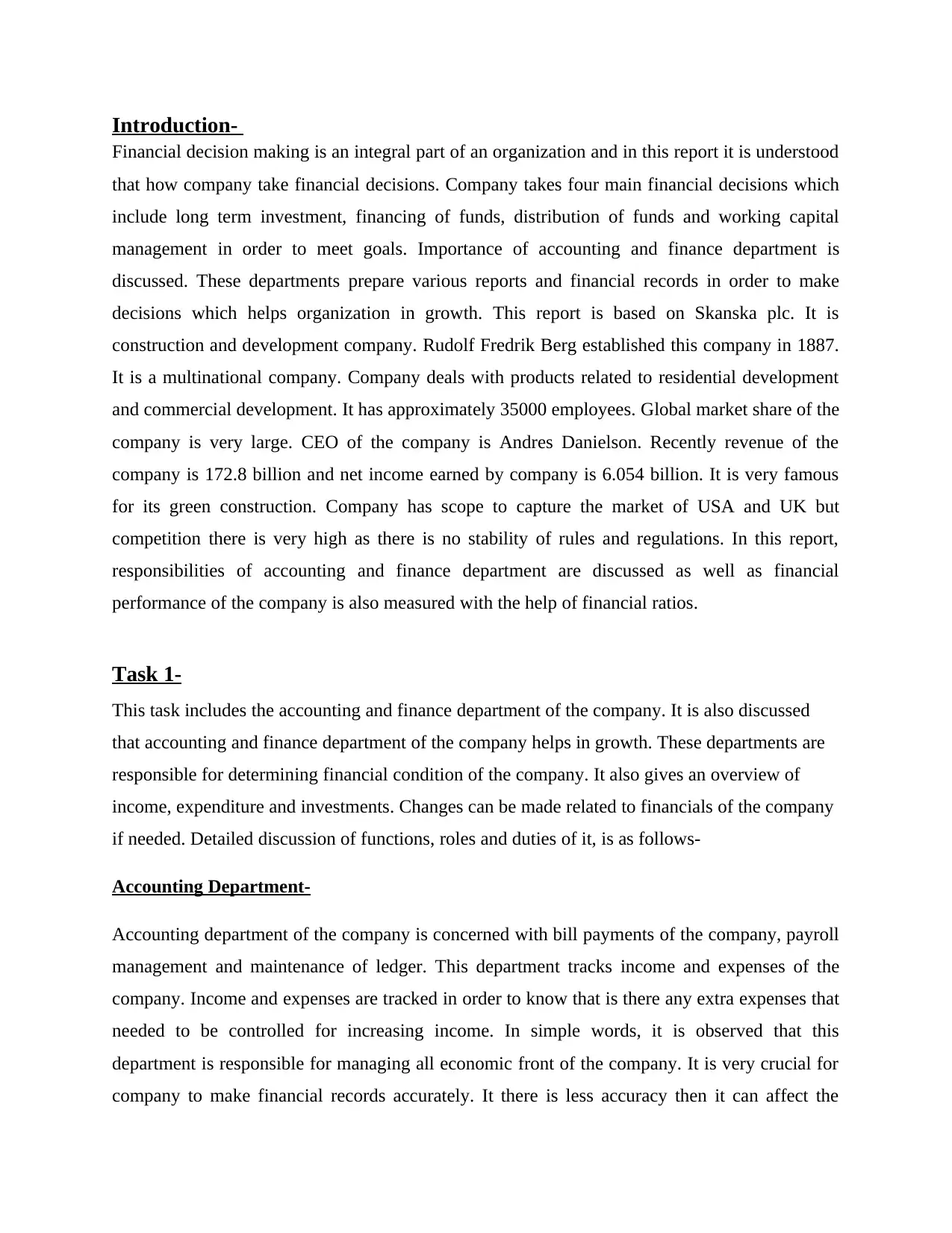
Introduction-
Financial decision making is an integral part of an organization and in this report it is understood
that how company take financial decisions. Company takes four main financial decisions which
include long term investment, financing of funds, distribution of funds and working capital
management in order to meet goals. Importance of accounting and finance department is
discussed. These departments prepare various reports and financial records in order to make
decisions which helps organization in growth. This report is based on Skanska plc. It is
construction and development company. Rudolf Fredrik Berg established this company in 1887.
It is a multinational company. Company deals with products related to residential development
and commercial development. It has approximately 35000 employees. Global market share of the
company is very large. CEO of the company is Andres Danielson. Recently revenue of the
company is 172.8 billion and net income earned by company is 6.054 billion. It is very famous
for its green construction. Company has scope to capture the market of USA and UK but
competition there is very high as there is no stability of rules and regulations. In this report,
responsibilities of accounting and finance department are discussed as well as financial
performance of the company is also measured with the help of financial ratios.
Task 1-
This task includes the accounting and finance department of the company. It is also discussed
that accounting and finance department of the company helps in growth. These departments are
responsible for determining financial condition of the company. It also gives an overview of
income, expenditure and investments. Changes can be made related to financials of the company
if needed. Detailed discussion of functions, roles and duties of it, is as follows-
Accounting Department-
Accounting department of the company is concerned with bill payments of the company, payroll
management and maintenance of ledger. This department tracks income and expenses of the
company. Income and expenses are tracked in order to know that is there any extra expenses that
needed to be controlled for increasing income. In simple words, it is observed that this
department is responsible for managing all economic front of the company. It is very crucial for
company to make financial records accurately. It there is less accuracy then it can affect the
Financial decision making is an integral part of an organization and in this report it is understood
that how company take financial decisions. Company takes four main financial decisions which
include long term investment, financing of funds, distribution of funds and working capital
management in order to meet goals. Importance of accounting and finance department is
discussed. These departments prepare various reports and financial records in order to make
decisions which helps organization in growth. This report is based on Skanska plc. It is
construction and development company. Rudolf Fredrik Berg established this company in 1887.
It is a multinational company. Company deals with products related to residential development
and commercial development. It has approximately 35000 employees. Global market share of the
company is very large. CEO of the company is Andres Danielson. Recently revenue of the
company is 172.8 billion and net income earned by company is 6.054 billion. It is very famous
for its green construction. Company has scope to capture the market of USA and UK but
competition there is very high as there is no stability of rules and regulations. In this report,
responsibilities of accounting and finance department are discussed as well as financial
performance of the company is also measured with the help of financial ratios.
Task 1-
This task includes the accounting and finance department of the company. It is also discussed
that accounting and finance department of the company helps in growth. These departments are
responsible for determining financial condition of the company. It also gives an overview of
income, expenditure and investments. Changes can be made related to financials of the company
if needed. Detailed discussion of functions, roles and duties of it, is as follows-
Accounting Department-
Accounting department of the company is concerned with bill payments of the company, payroll
management and maintenance of ledger. This department tracks income and expenses of the
company. Income and expenses are tracked in order to know that is there any extra expenses that
needed to be controlled for increasing income. In simple words, it is observed that this
department is responsible for managing all economic front of the company. It is very crucial for
company to make financial records accurately. It there is less accuracy then it can affect the
⊘ This is a preview!⊘
Do you want full access?
Subscribe today to unlock all pages.

Trusted by 1+ million students worldwide
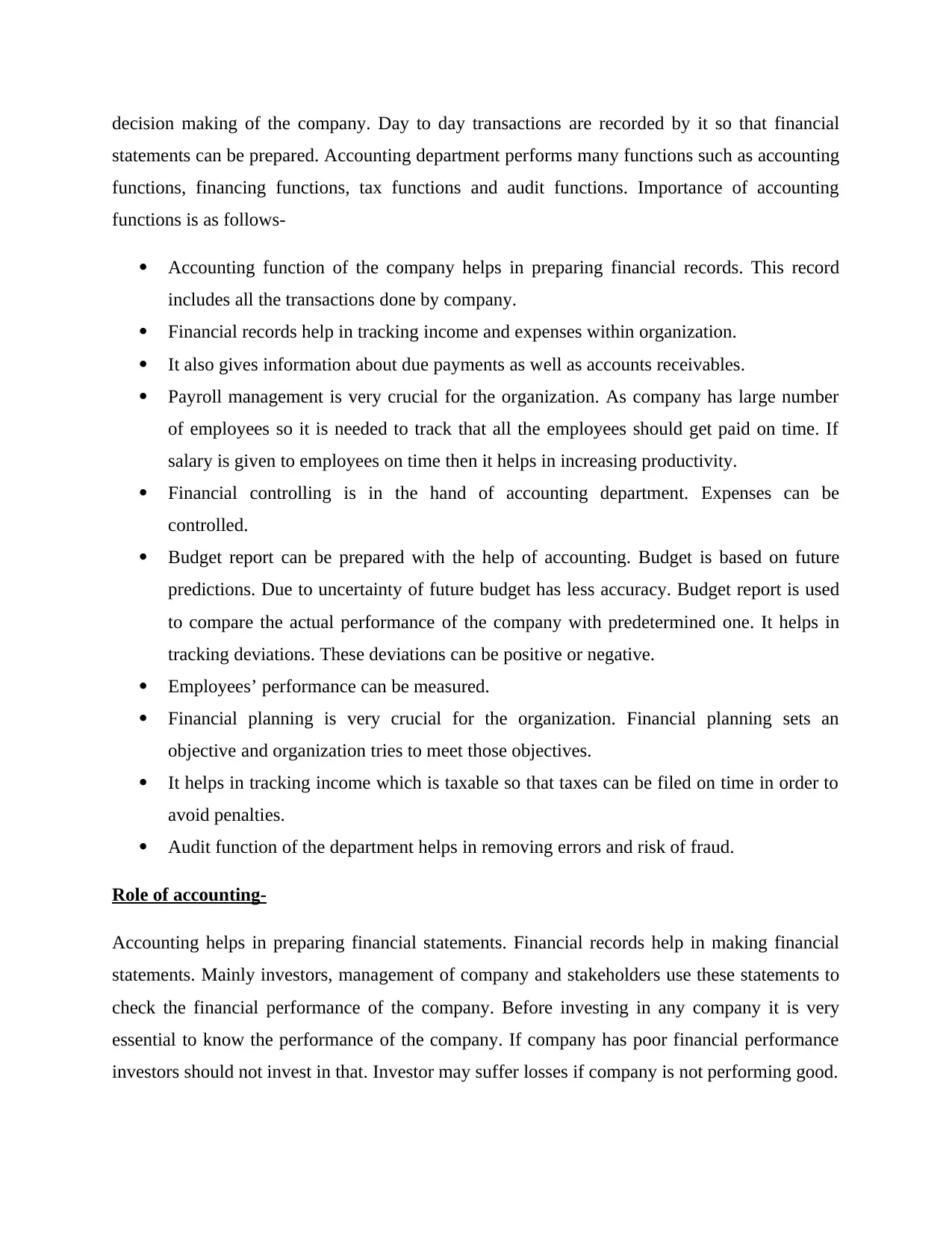
decision making of the company. Day to day transactions are recorded by it so that financial
statements can be prepared. Accounting department performs many functions such as accounting
functions, financing functions, tax functions and audit functions. Importance of accounting
functions is as follows-
Accounting function of the company helps in preparing financial records. This record
includes all the transactions done by company.
Financial records help in tracking income and expenses within organization.
It also gives information about due payments as well as accounts receivables.
Payroll management is very crucial for the organization. As company has large number
of employees so it is needed to track that all the employees should get paid on time. If
salary is given to employees on time then it helps in increasing productivity.
Financial controlling is in the hand of accounting department. Expenses can be
controlled.
Budget report can be prepared with the help of accounting. Budget is based on future
predictions. Due to uncertainty of future budget has less accuracy. Budget report is used
to compare the actual performance of the company with predetermined one. It helps in
tracking deviations. These deviations can be positive or negative.
Employees’ performance can be measured.
Financial planning is very crucial for the organization. Financial planning sets an
objective and organization tries to meet those objectives.
It helps in tracking income which is taxable so that taxes can be filed on time in order to
avoid penalties.
Audit function of the department helps in removing errors and risk of fraud.
Role of accounting-
Accounting helps in preparing financial statements. Financial records help in making financial
statements. Mainly investors, management of company and stakeholders use these statements to
check the financial performance of the company. Before investing in any company it is very
essential to know the performance of the company. If company has poor financial performance
investors should not invest in that. Investor may suffer losses if company is not performing good.
statements can be prepared. Accounting department performs many functions such as accounting
functions, financing functions, tax functions and audit functions. Importance of accounting
functions is as follows-
Accounting function of the company helps in preparing financial records. This record
includes all the transactions done by company.
Financial records help in tracking income and expenses within organization.
It also gives information about due payments as well as accounts receivables.
Payroll management is very crucial for the organization. As company has large number
of employees so it is needed to track that all the employees should get paid on time. If
salary is given to employees on time then it helps in increasing productivity.
Financial controlling is in the hand of accounting department. Expenses can be
controlled.
Budget report can be prepared with the help of accounting. Budget is based on future
predictions. Due to uncertainty of future budget has less accuracy. Budget report is used
to compare the actual performance of the company with predetermined one. It helps in
tracking deviations. These deviations can be positive or negative.
Employees’ performance can be measured.
Financial planning is very crucial for the organization. Financial planning sets an
objective and organization tries to meet those objectives.
It helps in tracking income which is taxable so that taxes can be filed on time in order to
avoid penalties.
Audit function of the department helps in removing errors and risk of fraud.
Role of accounting-
Accounting helps in preparing financial statements. Financial records help in making financial
statements. Mainly investors, management of company and stakeholders use these statements to
check the financial performance of the company. Before investing in any company it is very
essential to know the performance of the company. If company has poor financial performance
investors should not invest in that. Investor may suffer losses if company is not performing good.
Paraphrase This Document
Need a fresh take? Get an instant paraphrase of this document with our AI Paraphraser
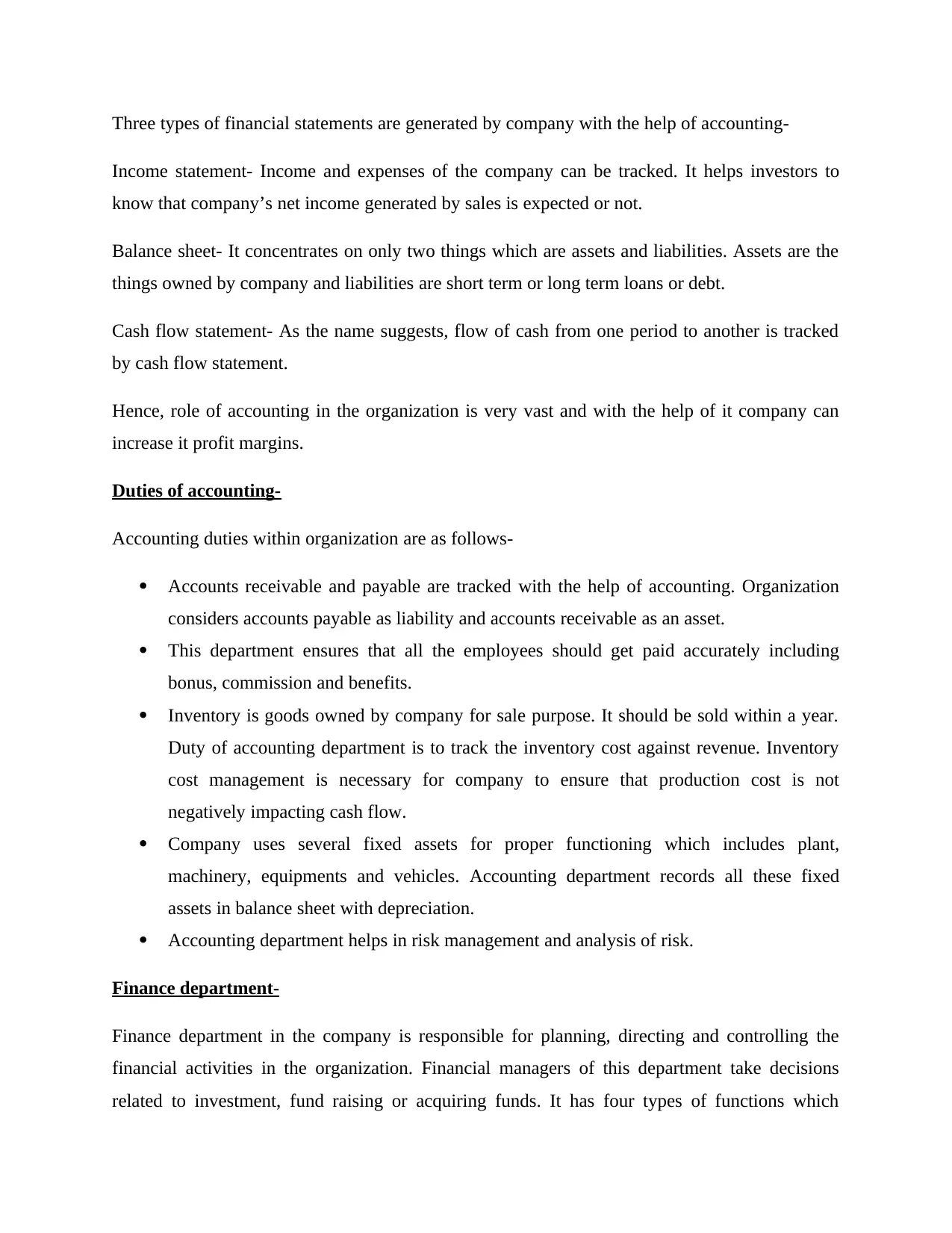
Three types of financial statements are generated by company with the help of accounting-
Income statement- Income and expenses of the company can be tracked. It helps investors to
know that company’s net income generated by sales is expected or not.
Balance sheet- It concentrates on only two things which are assets and liabilities. Assets are the
things owned by company and liabilities are short term or long term loans or debt.
Cash flow statement- As the name suggests, flow of cash from one period to another is tracked
by cash flow statement.
Hence, role of accounting in the organization is very vast and with the help of it company can
increase it profit margins.
Duties of accounting-
Accounting duties within organization are as follows-
Accounts receivable and payable are tracked with the help of accounting. Organization
considers accounts payable as liability and accounts receivable as an asset.
This department ensures that all the employees should get paid accurately including
bonus, commission and benefits.
Inventory is goods owned by company for sale purpose. It should be sold within a year.
Duty of accounting department is to track the inventory cost against revenue. Inventory
cost management is necessary for company to ensure that production cost is not
negatively impacting cash flow.
Company uses several fixed assets for proper functioning which includes plant,
machinery, equipments and vehicles. Accounting department records all these fixed
assets in balance sheet with depreciation.
Accounting department helps in risk management and analysis of risk.
Finance department-
Finance department in the company is responsible for planning, directing and controlling the
financial activities in the organization. Financial managers of this department take decisions
related to investment, fund raising or acquiring funds. It has four types of functions which
Income statement- Income and expenses of the company can be tracked. It helps investors to
know that company’s net income generated by sales is expected or not.
Balance sheet- It concentrates on only two things which are assets and liabilities. Assets are the
things owned by company and liabilities are short term or long term loans or debt.
Cash flow statement- As the name suggests, flow of cash from one period to another is tracked
by cash flow statement.
Hence, role of accounting in the organization is very vast and with the help of it company can
increase it profit margins.
Duties of accounting-
Accounting duties within organization are as follows-
Accounts receivable and payable are tracked with the help of accounting. Organization
considers accounts payable as liability and accounts receivable as an asset.
This department ensures that all the employees should get paid accurately including
bonus, commission and benefits.
Inventory is goods owned by company for sale purpose. It should be sold within a year.
Duty of accounting department is to track the inventory cost against revenue. Inventory
cost management is necessary for company to ensure that production cost is not
negatively impacting cash flow.
Company uses several fixed assets for proper functioning which includes plant,
machinery, equipments and vehicles. Accounting department records all these fixed
assets in balance sheet with depreciation.
Accounting department helps in risk management and analysis of risk.
Finance department-
Finance department in the company is responsible for planning, directing and controlling the
financial activities in the organization. Financial managers of this department take decisions
related to investment, fund raising or acquiring funds. It has four types of functions which
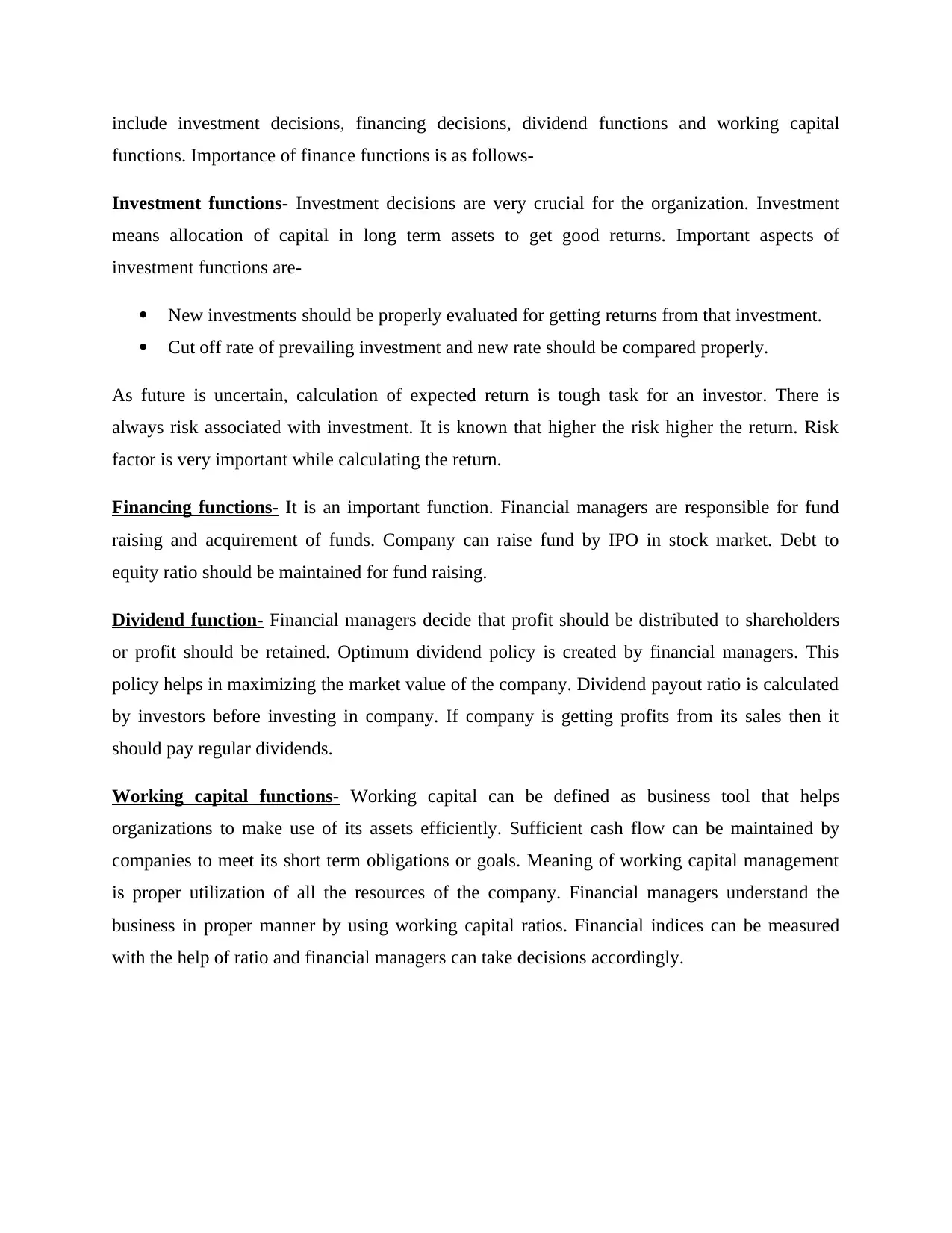
include investment decisions, financing decisions, dividend functions and working capital
functions. Importance of finance functions is as follows-
Investment functions- Investment decisions are very crucial for the organization. Investment
means allocation of capital in long term assets to get good returns. Important aspects of
investment functions are-
New investments should be properly evaluated for getting returns from that investment.
Cut off rate of prevailing investment and new rate should be compared properly.
As future is uncertain, calculation of expected return is tough task for an investor. There is
always risk associated with investment. It is known that higher the risk higher the return. Risk
factor is very important while calculating the return.
Financing functions- It is an important function. Financial managers are responsible for fund
raising and acquirement of funds. Company can raise fund by IPO in stock market. Debt to
equity ratio should be maintained for fund raising.
Dividend function- Financial managers decide that profit should be distributed to shareholders
or profit should be retained. Optimum dividend policy is created by financial managers. This
policy helps in maximizing the market value of the company. Dividend payout ratio is calculated
by investors before investing in company. If company is getting profits from its sales then it
should pay regular dividends.
Working capital functions- Working capital can be defined as business tool that helps
organizations to make use of its assets efficiently. Sufficient cash flow can be maintained by
companies to meet its short term obligations or goals. Meaning of working capital management
is proper utilization of all the resources of the company. Financial managers understand the
business in proper manner by using working capital ratios. Financial indices can be measured
with the help of ratio and financial managers can take decisions accordingly.
functions. Importance of finance functions is as follows-
Investment functions- Investment decisions are very crucial for the organization. Investment
means allocation of capital in long term assets to get good returns. Important aspects of
investment functions are-
New investments should be properly evaluated for getting returns from that investment.
Cut off rate of prevailing investment and new rate should be compared properly.
As future is uncertain, calculation of expected return is tough task for an investor. There is
always risk associated with investment. It is known that higher the risk higher the return. Risk
factor is very important while calculating the return.
Financing functions- It is an important function. Financial managers are responsible for fund
raising and acquirement of funds. Company can raise fund by IPO in stock market. Debt to
equity ratio should be maintained for fund raising.
Dividend function- Financial managers decide that profit should be distributed to shareholders
or profit should be retained. Optimum dividend policy is created by financial managers. This
policy helps in maximizing the market value of the company. Dividend payout ratio is calculated
by investors before investing in company. If company is getting profits from its sales then it
should pay regular dividends.
Working capital functions- Working capital can be defined as business tool that helps
organizations to make use of its assets efficiently. Sufficient cash flow can be maintained by
companies to meet its short term obligations or goals. Meaning of working capital management
is proper utilization of all the resources of the company. Financial managers understand the
business in proper manner by using working capital ratios. Financial indices can be measured
with the help of ratio and financial managers can take decisions accordingly.
⊘ This is a preview!⊘
Do you want full access?
Subscribe today to unlock all pages.

Trusted by 1+ million students worldwide
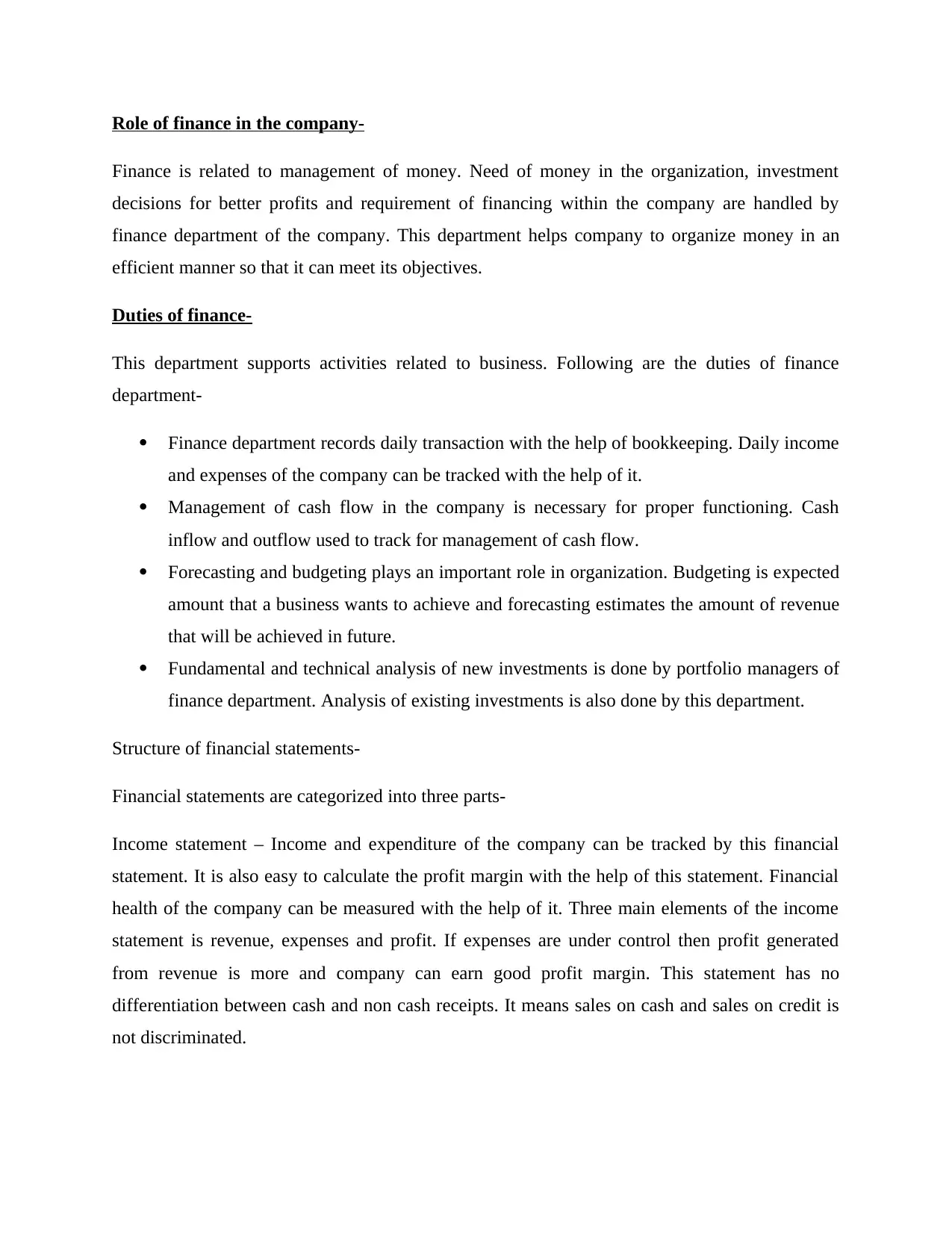
Role of finance in the company-
Finance is related to management of money. Need of money in the organization, investment
decisions for better profits and requirement of financing within the company are handled by
finance department of the company. This department helps company to organize money in an
efficient manner so that it can meet its objectives.
Duties of finance-
This department supports activities related to business. Following are the duties of finance
department-
Finance department records daily transaction with the help of bookkeeping. Daily income
and expenses of the company can be tracked with the help of it.
Management of cash flow in the company is necessary for proper functioning. Cash
inflow and outflow used to track for management of cash flow.
Forecasting and budgeting plays an important role in organization. Budgeting is expected
amount that a business wants to achieve and forecasting estimates the amount of revenue
that will be achieved in future.
Fundamental and technical analysis of new investments is done by portfolio managers of
finance department. Analysis of existing investments is also done by this department.
Structure of financial statements-
Financial statements are categorized into three parts-
Income statement – Income and expenditure of the company can be tracked by this financial
statement. It is also easy to calculate the profit margin with the help of this statement. Financial
health of the company can be measured with the help of it. Three main elements of the income
statement is revenue, expenses and profit. If expenses are under control then profit generated
from revenue is more and company can earn good profit margin. This statement has no
differentiation between cash and non cash receipts. It means sales on cash and sales on credit is
not discriminated.
Finance is related to management of money. Need of money in the organization, investment
decisions for better profits and requirement of financing within the company are handled by
finance department of the company. This department helps company to organize money in an
efficient manner so that it can meet its objectives.
Duties of finance-
This department supports activities related to business. Following are the duties of finance
department-
Finance department records daily transaction with the help of bookkeeping. Daily income
and expenses of the company can be tracked with the help of it.
Management of cash flow in the company is necessary for proper functioning. Cash
inflow and outflow used to track for management of cash flow.
Forecasting and budgeting plays an important role in organization. Budgeting is expected
amount that a business wants to achieve and forecasting estimates the amount of revenue
that will be achieved in future.
Fundamental and technical analysis of new investments is done by portfolio managers of
finance department. Analysis of existing investments is also done by this department.
Structure of financial statements-
Financial statements are categorized into three parts-
Income statement – Income and expenditure of the company can be tracked by this financial
statement. It is also easy to calculate the profit margin with the help of this statement. Financial
health of the company can be measured with the help of it. Three main elements of the income
statement is revenue, expenses and profit. If expenses are under control then profit generated
from revenue is more and company can earn good profit margin. This statement has no
differentiation between cash and non cash receipts. It means sales on cash and sales on credit is
not discriminated.
Paraphrase This Document
Need a fresh take? Get an instant paraphrase of this document with our AI Paraphraser
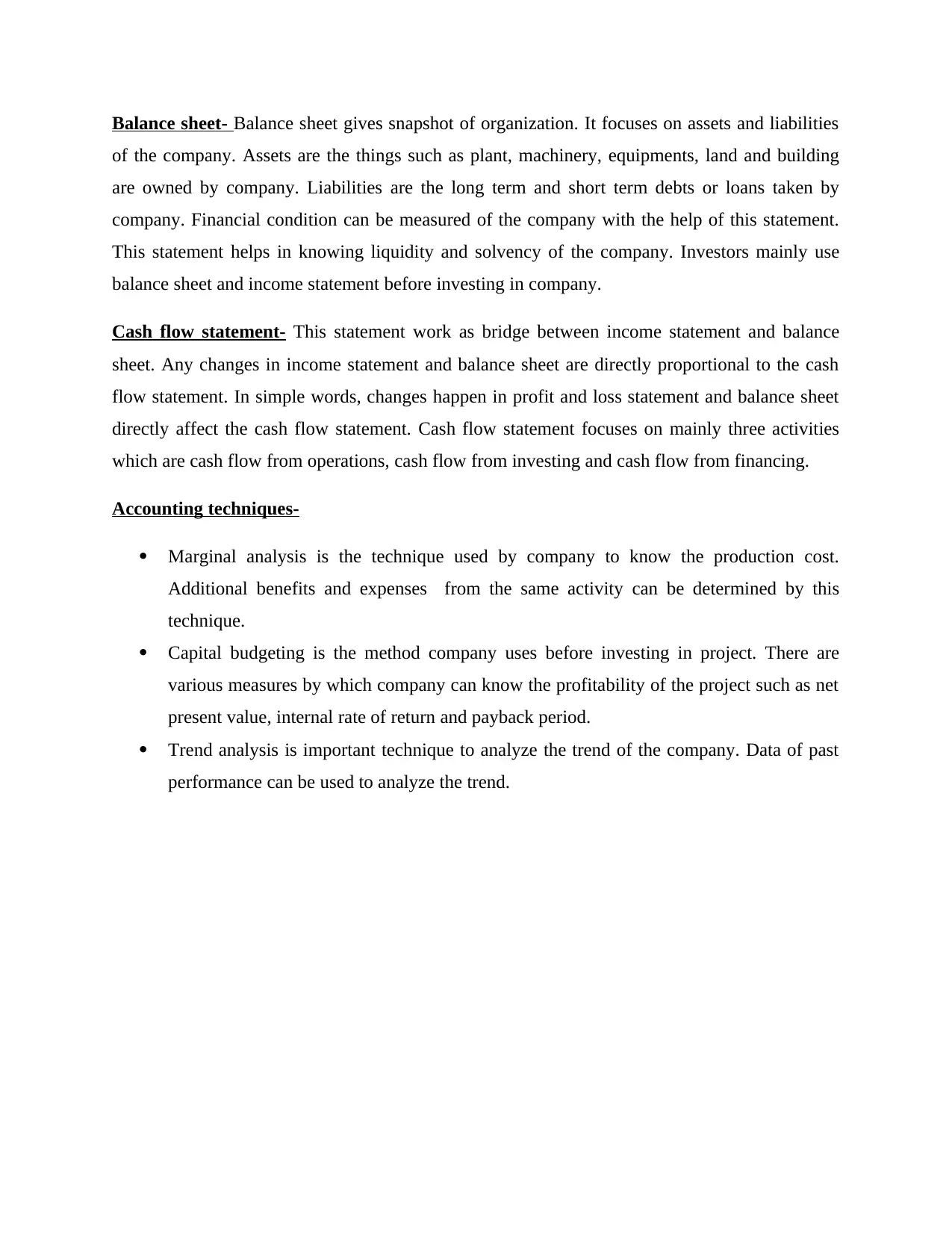
Balance sheet- Balance sheet gives snapshot of organization. It focuses on assets and liabilities
of the company. Assets are the things such as plant, machinery, equipments, land and building
are owned by company. Liabilities are the long term and short term debts or loans taken by
company. Financial condition can be measured of the company with the help of this statement.
This statement helps in knowing liquidity and solvency of the company. Investors mainly use
balance sheet and income statement before investing in company.
Cash flow statement- This statement work as bridge between income statement and balance
sheet. Any changes in income statement and balance sheet are directly proportional to the cash
flow statement. In simple words, changes happen in profit and loss statement and balance sheet
directly affect the cash flow statement. Cash flow statement focuses on mainly three activities
which are cash flow from operations, cash flow from investing and cash flow from financing.
Accounting techniques-
Marginal analysis is the technique used by company to know the production cost.
Additional benefits and expenses from the same activity can be determined by this
technique.
Capital budgeting is the method company uses before investing in project. There are
various measures by which company can know the profitability of the project such as net
present value, internal rate of return and payback period.
Trend analysis is important technique to analyze the trend of the company. Data of past
performance can be used to analyze the trend.
of the company. Assets are the things such as plant, machinery, equipments, land and building
are owned by company. Liabilities are the long term and short term debts or loans taken by
company. Financial condition can be measured of the company with the help of this statement.
This statement helps in knowing liquidity and solvency of the company. Investors mainly use
balance sheet and income statement before investing in company.
Cash flow statement- This statement work as bridge between income statement and balance
sheet. Any changes in income statement and balance sheet are directly proportional to the cash
flow statement. In simple words, changes happen in profit and loss statement and balance sheet
directly affect the cash flow statement. Cash flow statement focuses on mainly three activities
which are cash flow from operations, cash flow from investing and cash flow from financing.
Accounting techniques-
Marginal analysis is the technique used by company to know the production cost.
Additional benefits and expenses from the same activity can be determined by this
technique.
Capital budgeting is the method company uses before investing in project. There are
various measures by which company can know the profitability of the project such as net
present value, internal rate of return and payback period.
Trend analysis is important technique to analyze the trend of the company. Data of past
performance can be used to analyze the trend.
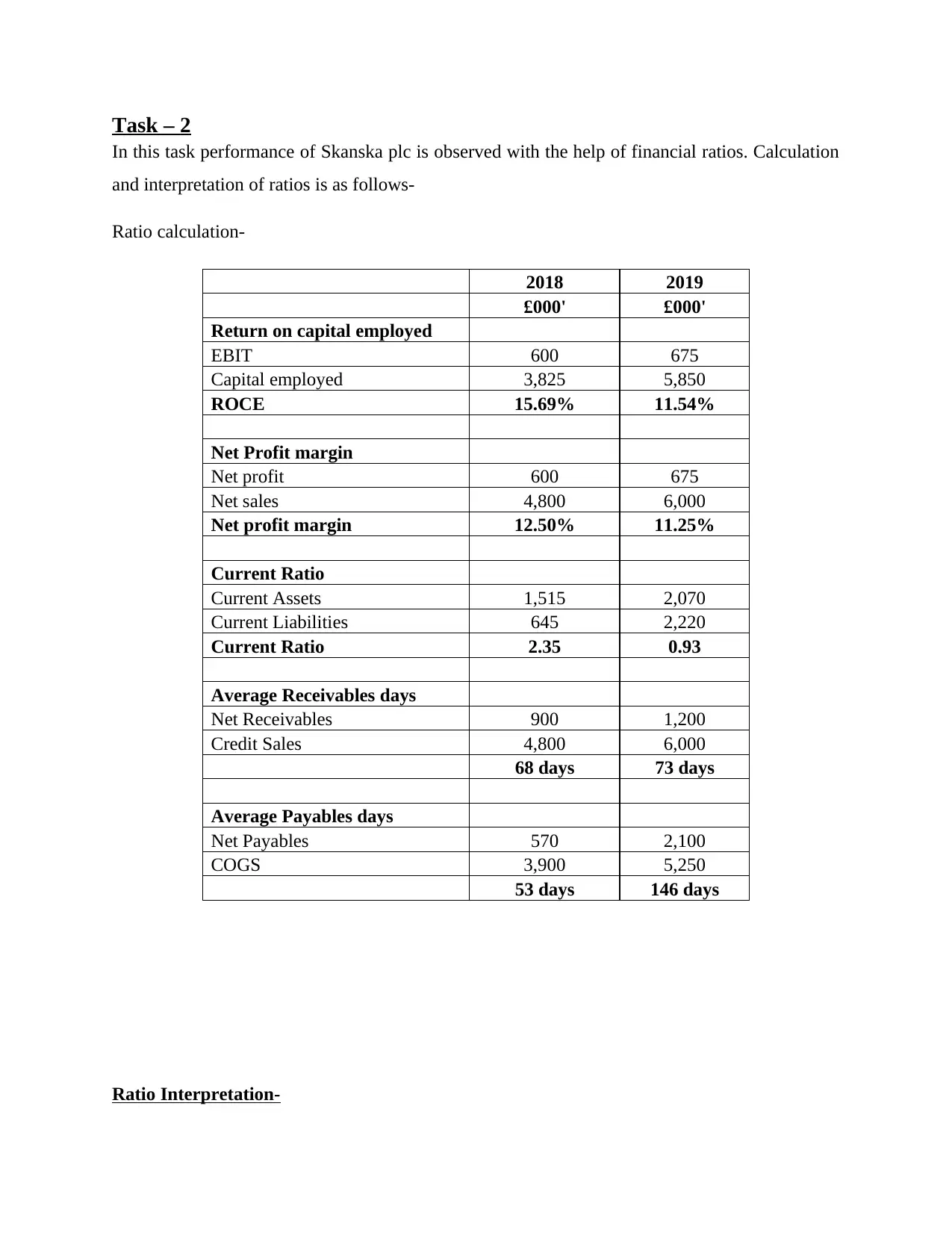
Task – 2
In this task performance of Skanska plc is observed with the help of financial ratios. Calculation
and interpretation of ratios is as follows-
Ratio calculation-
2018 2019
£000' £000'
Return on capital employed
EBIT 600 675
Capital employed 3,825 5,850
ROCE 15.69% 11.54%
Net Profit margin
Net profit 600 675
Net sales 4,800 6,000
Net profit margin 12.50% 11.25%
Current Ratio
Current Assets 1,515 2,070
Current Liabilities 645 2,220
Current Ratio 2.35 0.93
Average Receivables days
Net Receivables 900 1,200
Credit Sales 4,800 6,000
68 days 73 days
Average Payables days
Net Payables 570 2,100
COGS 3,900 5,250
53 days 146 days
Ratio Interpretation-
In this task performance of Skanska plc is observed with the help of financial ratios. Calculation
and interpretation of ratios is as follows-
Ratio calculation-
2018 2019
£000' £000'
Return on capital employed
EBIT 600 675
Capital employed 3,825 5,850
ROCE 15.69% 11.54%
Net Profit margin
Net profit 600 675
Net sales 4,800 6,000
Net profit margin 12.50% 11.25%
Current Ratio
Current Assets 1,515 2,070
Current Liabilities 645 2,220
Current Ratio 2.35 0.93
Average Receivables days
Net Receivables 900 1,200
Credit Sales 4,800 6,000
68 days 73 days
Average Payables days
Net Payables 570 2,100
COGS 3,900 5,250
53 days 146 days
Ratio Interpretation-
⊘ This is a preview!⊘
Do you want full access?
Subscribe today to unlock all pages.

Trusted by 1+ million students worldwide
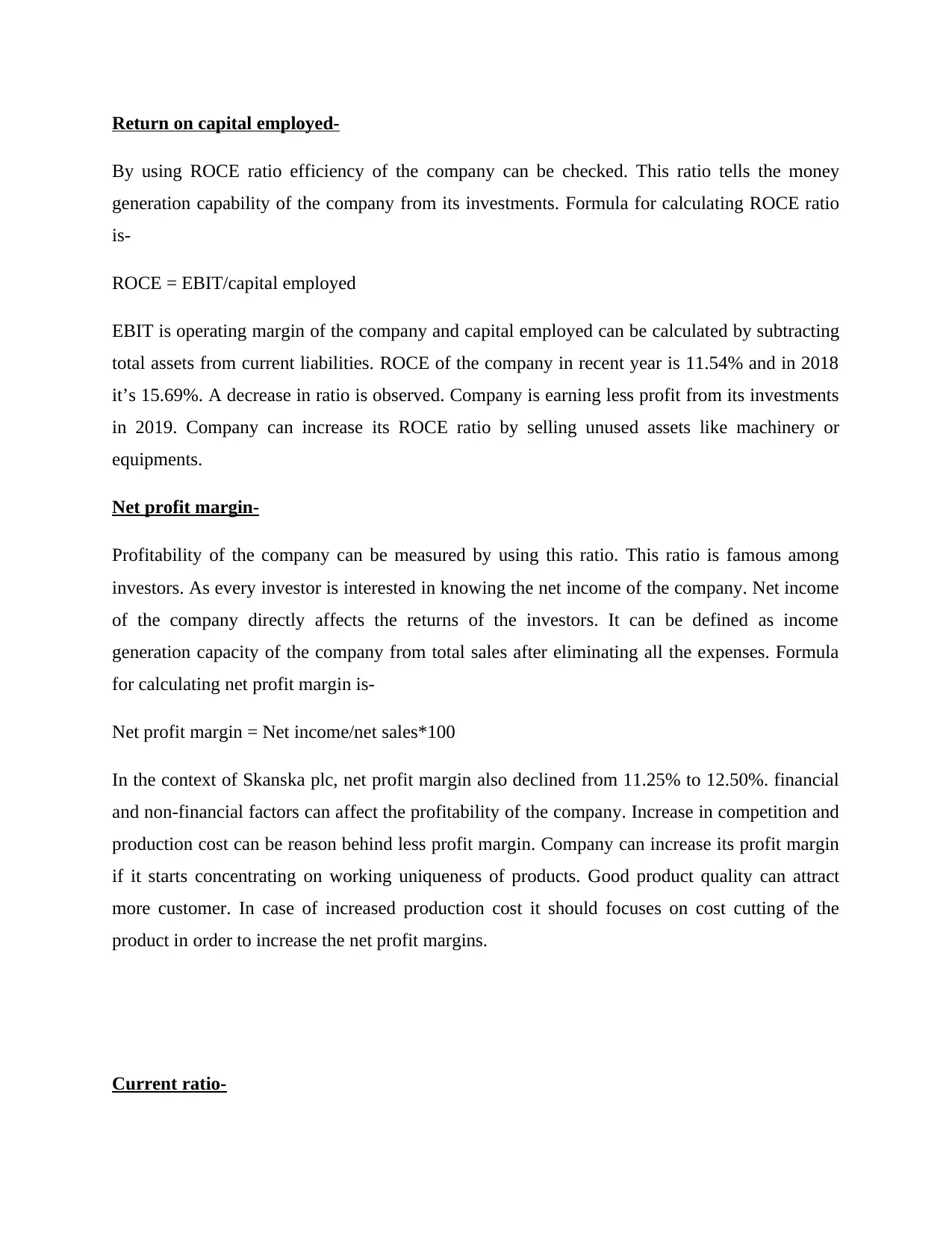
Return on capital employed-
By using ROCE ratio efficiency of the company can be checked. This ratio tells the money
generation capability of the company from its investments. Formula for calculating ROCE ratio
is-
ROCE = EBIT/capital employed
EBIT is operating margin of the company and capital employed can be calculated by subtracting
total assets from current liabilities. ROCE of the company in recent year is 11.54% and in 2018
it’s 15.69%. A decrease in ratio is observed. Company is earning less profit from its investments
in 2019. Company can increase its ROCE ratio by selling unused assets like machinery or
equipments.
Net profit margin-
Profitability of the company can be measured by using this ratio. This ratio is famous among
investors. As every investor is interested in knowing the net income of the company. Net income
of the company directly affects the returns of the investors. It can be defined as income
generation capacity of the company from total sales after eliminating all the expenses. Formula
for calculating net profit margin is-
Net profit margin = Net income/net sales*100
In the context of Skanska plc, net profit margin also declined from 11.25% to 12.50%. financial
and non-financial factors can affect the profitability of the company. Increase in competition and
production cost can be reason behind less profit margin. Company can increase its profit margin
if it starts concentrating on working uniqueness of products. Good product quality can attract
more customer. In case of increased production cost it should focuses on cost cutting of the
product in order to increase the net profit margins.
Current ratio-
By using ROCE ratio efficiency of the company can be checked. This ratio tells the money
generation capability of the company from its investments. Formula for calculating ROCE ratio
is-
ROCE = EBIT/capital employed
EBIT is operating margin of the company and capital employed can be calculated by subtracting
total assets from current liabilities. ROCE of the company in recent year is 11.54% and in 2018
it’s 15.69%. A decrease in ratio is observed. Company is earning less profit from its investments
in 2019. Company can increase its ROCE ratio by selling unused assets like machinery or
equipments.
Net profit margin-
Profitability of the company can be measured by using this ratio. This ratio is famous among
investors. As every investor is interested in knowing the net income of the company. Net income
of the company directly affects the returns of the investors. It can be defined as income
generation capacity of the company from total sales after eliminating all the expenses. Formula
for calculating net profit margin is-
Net profit margin = Net income/net sales*100
In the context of Skanska plc, net profit margin also declined from 11.25% to 12.50%. financial
and non-financial factors can affect the profitability of the company. Increase in competition and
production cost can be reason behind less profit margin. Company can increase its profit margin
if it starts concentrating on working uniqueness of products. Good product quality can attract
more customer. In case of increased production cost it should focuses on cost cutting of the
product in order to increase the net profit margins.
Current ratio-
Paraphrase This Document
Need a fresh take? Get an instant paraphrase of this document with our AI Paraphraser
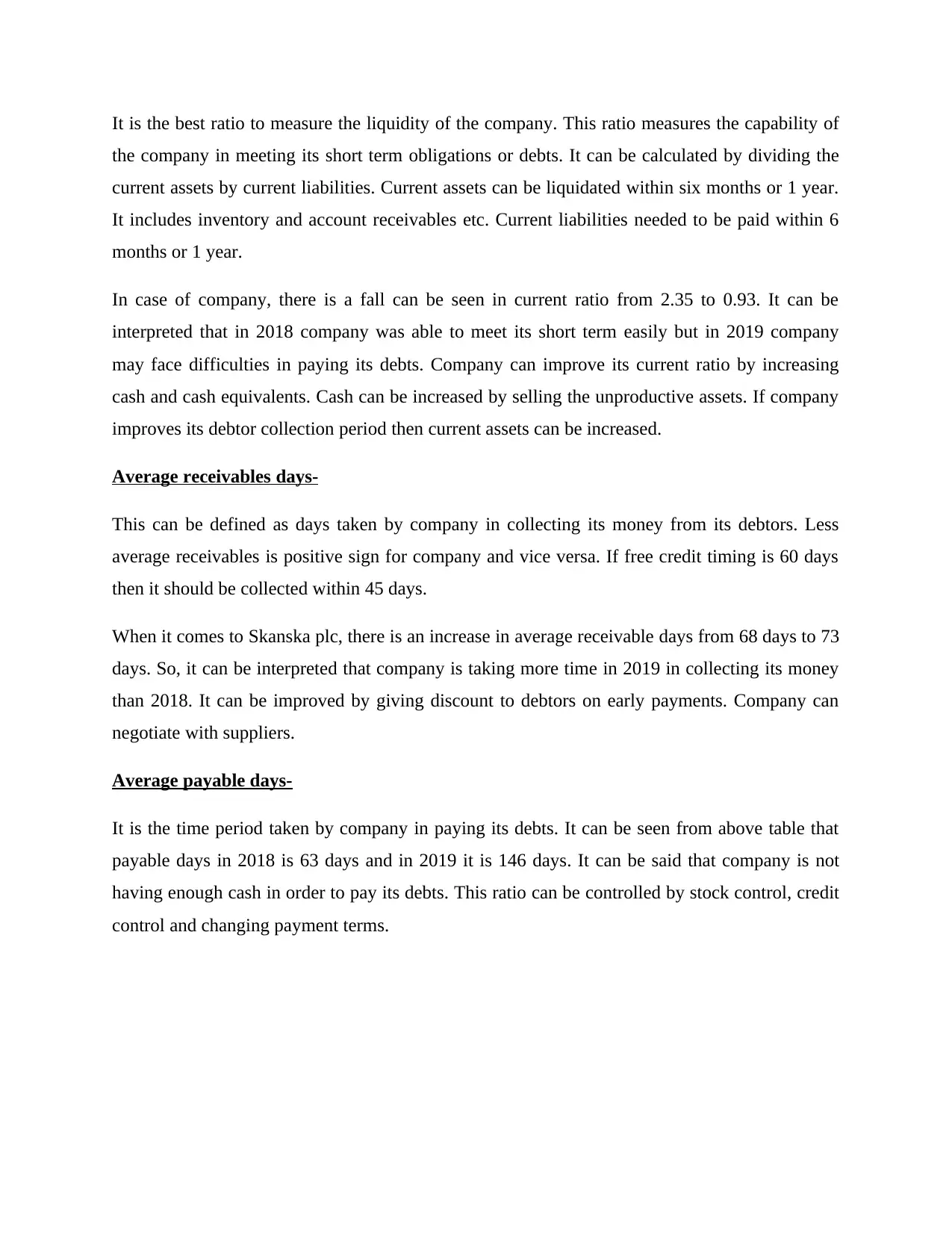
It is the best ratio to measure the liquidity of the company. This ratio measures the capability of
the company in meeting its short term obligations or debts. It can be calculated by dividing the
current assets by current liabilities. Current assets can be liquidated within six months or 1 year.
It includes inventory and account receivables etc. Current liabilities needed to be paid within 6
months or 1 year.
In case of company, there is a fall can be seen in current ratio from 2.35 to 0.93. It can be
interpreted that in 2018 company was able to meet its short term easily but in 2019 company
may face difficulties in paying its debts. Company can improve its current ratio by increasing
cash and cash equivalents. Cash can be increased by selling the unproductive assets. If company
improves its debtor collection period then current assets can be increased.
Average receivables days-
This can be defined as days taken by company in collecting its money from its debtors. Less
average receivables is positive sign for company and vice versa. If free credit timing is 60 days
then it should be collected within 45 days.
When it comes to Skanska plc, there is an increase in average receivable days from 68 days to 73
days. So, it can be interpreted that company is taking more time in 2019 in collecting its money
than 2018. It can be improved by giving discount to debtors on early payments. Company can
negotiate with suppliers.
Average payable days-
It is the time period taken by company in paying its debts. It can be seen from above table that
payable days in 2018 is 63 days and in 2019 it is 146 days. It can be said that company is not
having enough cash in order to pay its debts. This ratio can be controlled by stock control, credit
control and changing payment terms.
the company in meeting its short term obligations or debts. It can be calculated by dividing the
current assets by current liabilities. Current assets can be liquidated within six months or 1 year.
It includes inventory and account receivables etc. Current liabilities needed to be paid within 6
months or 1 year.
In case of company, there is a fall can be seen in current ratio from 2.35 to 0.93. It can be
interpreted that in 2018 company was able to meet its short term easily but in 2019 company
may face difficulties in paying its debts. Company can improve its current ratio by increasing
cash and cash equivalents. Cash can be increased by selling the unproductive assets. If company
improves its debtor collection period then current assets can be increased.
Average receivables days-
This can be defined as days taken by company in collecting its money from its debtors. Less
average receivables is positive sign for company and vice versa. If free credit timing is 60 days
then it should be collected within 45 days.
When it comes to Skanska plc, there is an increase in average receivable days from 68 days to 73
days. So, it can be interpreted that company is taking more time in 2019 in collecting its money
than 2018. It can be improved by giving discount to debtors on early payments. Company can
negotiate with suppliers.
Average payable days-
It is the time period taken by company in paying its debts. It can be seen from above table that
payable days in 2018 is 63 days and in 2019 it is 146 days. It can be said that company is not
having enough cash in order to pay its debts. This ratio can be controlled by stock control, credit
control and changing payment terms.
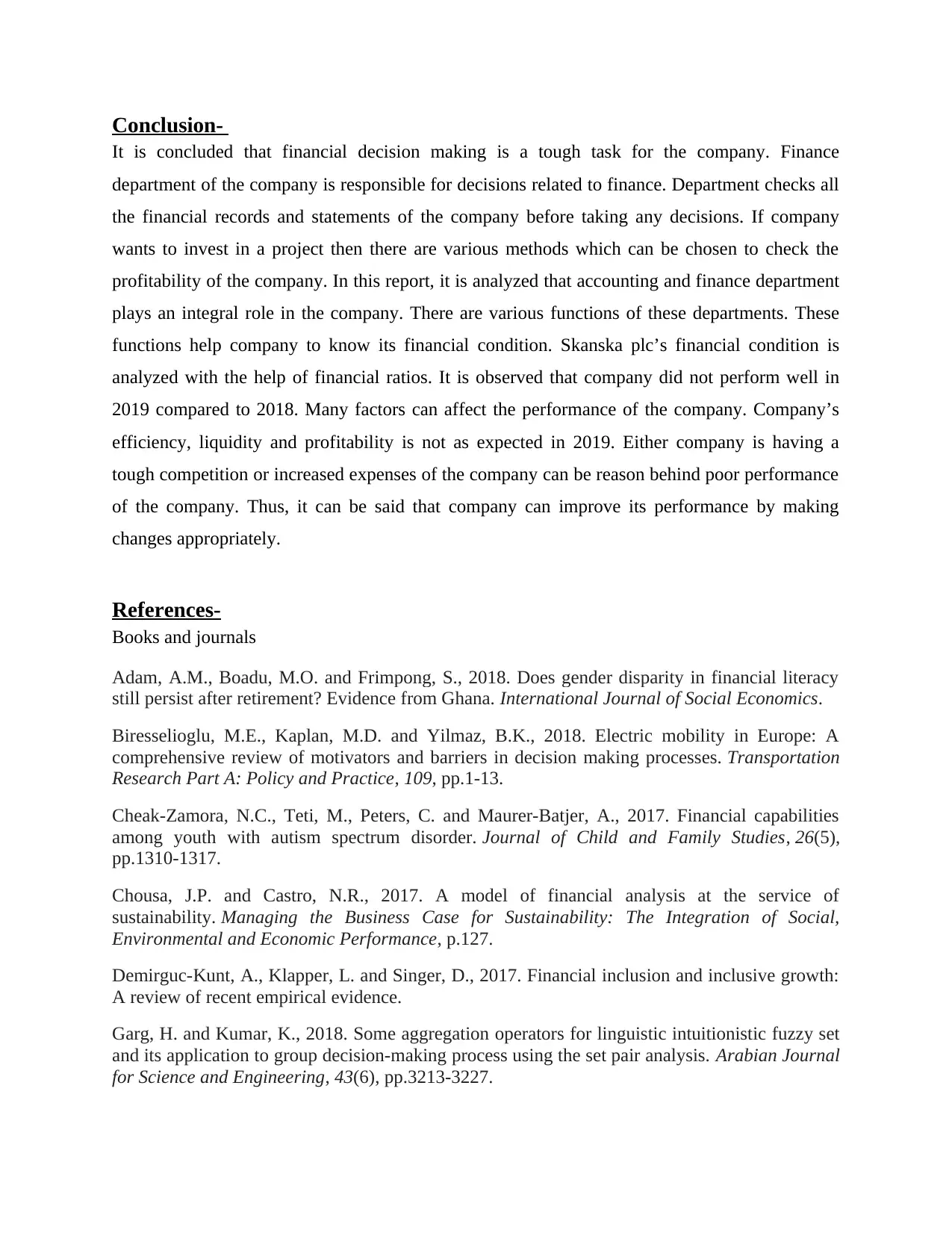
Conclusion-
It is concluded that financial decision making is a tough task for the company. Finance
department of the company is responsible for decisions related to finance. Department checks all
the financial records and statements of the company before taking any decisions. If company
wants to invest in a project then there are various methods which can be chosen to check the
profitability of the company. In this report, it is analyzed that accounting and finance department
plays an integral role in the company. There are various functions of these departments. These
functions help company to know its financial condition. Skanska plc’s financial condition is
analyzed with the help of financial ratios. It is observed that company did not perform well in
2019 compared to 2018. Many factors can affect the performance of the company. Company’s
efficiency, liquidity and profitability is not as expected in 2019. Either company is having a
tough competition or increased expenses of the company can be reason behind poor performance
of the company. Thus, it can be said that company can improve its performance by making
changes appropriately.
References-
Books and journals
Adam, A.M., Boadu, M.O. and Frimpong, S., 2018. Does gender disparity in financial literacy
still persist after retirement? Evidence from Ghana. International Journal of Social Economics.
Biresselioglu, M.E., Kaplan, M.D. and Yilmaz, B.K., 2018. Electric mobility in Europe: A
comprehensive review of motivators and barriers in decision making processes. Transportation
Research Part A: Policy and Practice, 109, pp.1-13.
Cheak-Zamora, N.C., Teti, M., Peters, C. and Maurer-Batjer, A., 2017. Financial capabilities
among youth with autism spectrum disorder. Journal of Child and Family Studies, 26(5),
pp.1310-1317.
Chousa, J.P. and Castro, N.R., 2017. A model of financial analysis at the service of
sustainability. Managing the Business Case for Sustainability: The Integration of Social,
Environmental and Economic Performance, p.127.
Demirguc-Kunt, A., Klapper, L. and Singer, D., 2017. Financial inclusion and inclusive growth:
A review of recent empirical evidence.
Garg, H. and Kumar, K., 2018. Some aggregation operators for linguistic intuitionistic fuzzy set
and its application to group decision-making process using the set pair analysis. Arabian Journal
for Science and Engineering, 43(6), pp.3213-3227.
It is concluded that financial decision making is a tough task for the company. Finance
department of the company is responsible for decisions related to finance. Department checks all
the financial records and statements of the company before taking any decisions. If company
wants to invest in a project then there are various methods which can be chosen to check the
profitability of the company. In this report, it is analyzed that accounting and finance department
plays an integral role in the company. There are various functions of these departments. These
functions help company to know its financial condition. Skanska plc’s financial condition is
analyzed with the help of financial ratios. It is observed that company did not perform well in
2019 compared to 2018. Many factors can affect the performance of the company. Company’s
efficiency, liquidity and profitability is not as expected in 2019. Either company is having a
tough competition or increased expenses of the company can be reason behind poor performance
of the company. Thus, it can be said that company can improve its performance by making
changes appropriately.
References-
Books and journals
Adam, A.M., Boadu, M.O. and Frimpong, S., 2018. Does gender disparity in financial literacy
still persist after retirement? Evidence from Ghana. International Journal of Social Economics.
Biresselioglu, M.E., Kaplan, M.D. and Yilmaz, B.K., 2018. Electric mobility in Europe: A
comprehensive review of motivators and barriers in decision making processes. Transportation
Research Part A: Policy and Practice, 109, pp.1-13.
Cheak-Zamora, N.C., Teti, M., Peters, C. and Maurer-Batjer, A., 2017. Financial capabilities
among youth with autism spectrum disorder. Journal of Child and Family Studies, 26(5),
pp.1310-1317.
Chousa, J.P. and Castro, N.R., 2017. A model of financial analysis at the service of
sustainability. Managing the Business Case for Sustainability: The Integration of Social,
Environmental and Economic Performance, p.127.
Demirguc-Kunt, A., Klapper, L. and Singer, D., 2017. Financial inclusion and inclusive growth:
A review of recent empirical evidence.
Garg, H. and Kumar, K., 2018. Some aggregation operators for linguistic intuitionistic fuzzy set
and its application to group decision-making process using the set pair analysis. Arabian Journal
for Science and Engineering, 43(6), pp.3213-3227.
⊘ This is a preview!⊘
Do you want full access?
Subscribe today to unlock all pages.

Trusted by 1+ million students worldwide
1 out of 13
Related Documents
Your All-in-One AI-Powered Toolkit for Academic Success.
+13062052269
info@desklib.com
Available 24*7 on WhatsApp / Email
![[object Object]](/_next/static/media/star-bottom.7253800d.svg)
Unlock your academic potential
Copyright © 2020–2025 A2Z Services. All Rights Reserved. Developed and managed by ZUCOL.





